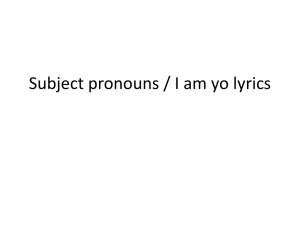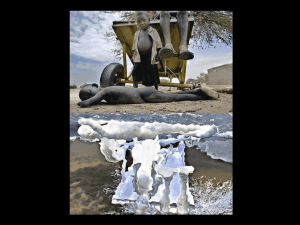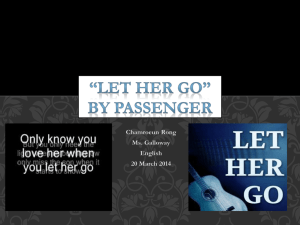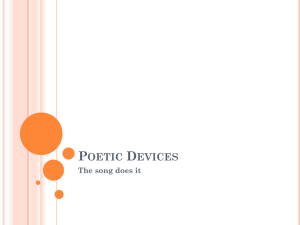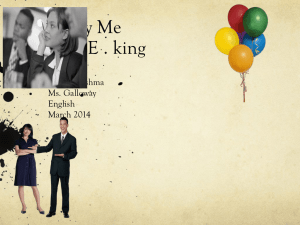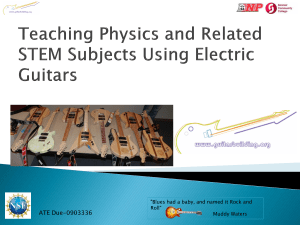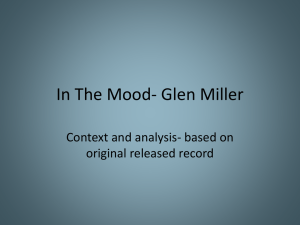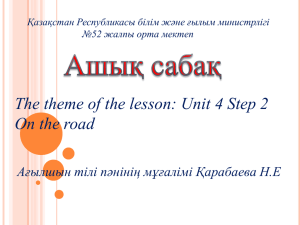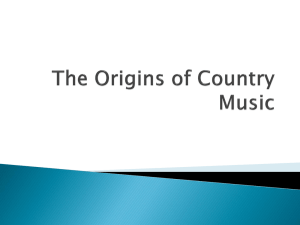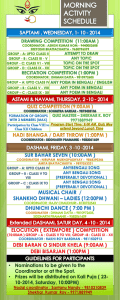The Appraisal - musicgcse.com
advertisement
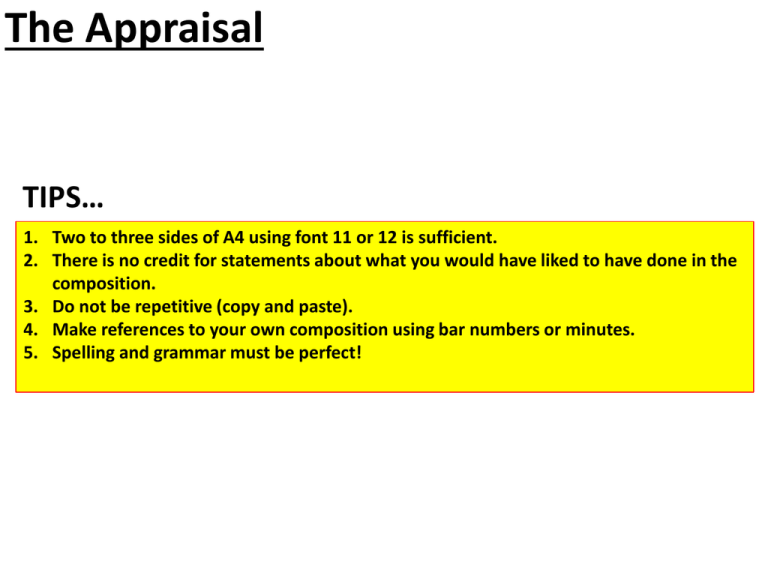
The Appraisal TIPS… 1. Two to three sides of A4 using font 11 or 12 is sufficient. 2. There is no credit for statements about what you would have liked to have done in the composition. 3. Do not be repetitive (copy and paste). 4. Make references to your own composition using bar numbers or minutes. 5. Spelling and grammar must be perfect! Example material Through-out this we’re going to look at two of last pupils work, both of whom received A* for this module. PARKER:PERRY R 36 / 40 HEGARTY:DAVID J 37 / 40 Question 1 1 - What Areas of Study did you choose and what is the focus of your composition within the given strand? Say what areas of study you have chosen then say what particular focus you have concentrated on within the pop music strand (World Music). EASY! – 10 mins AoS1: Rhythm and Metre • • • • • Free rhythm Syncopation Polyrhythms Rhythmic imitation Cross-rhythm • • • Singing in harmony (3rds /5ths) Use of chords I, IV & V Use of a drone • • • • • • • • Melody and accompaniment Pentatonic scale Modal scale A capella Raga Ornamentation Improvisation Layered textures • • • • Generic instruments, such as the sitar, dilruba or tabla Steel bands Instrumental techniques Contrasting/shading of dynamics • • • • Call and response Sectional compositions Pieces which gradually evolve/develop Latin-American dance forms AoS2: Harmony and Tonality AoS3: Texture and Melody AoS4: Timbre and Dynamics AoS5: Structure and Form Question 2 2 - Why did you choose these Areas of Study and the particular focus within the given strand? Give a little detail about what artist and what it is about their music that influenced your composition. Then go on to speak about the specific features / elements of the Areas of study you have chosen; If possible Include why you added each feature / element. Then do the same for the focus within the strand. Question 2 - Example David Hegarty Q2 2 - Why did you choose these Areas of Study and the particular focus within the given strand? Blink 182 are at the forefront of pop/punk rock music, and are recognised as one of the most prominent and long running bands within the genre. What attracted me most about their style of music is its simplicity, yet catchiness and the different layers applied. For example, a typical progression through one of their songs would be a chord progression accompanied by a riff. Octave power chords are also a typical musical feature used by the band, giving a sharp edge to their verses and choruses. This is why I chose my two Areas of Study. More specifically in timbre and dynamics, I concentrated on distortion and multi-tracking. Distortion is used throughout my piece, as is common with the pop/punk rock genre which gives it a hard, heavy edge. Multi-tracking is also present, most notably in the intro. Rhythm and meter was an easy decision for me, as my song has heavily syncopated drum beats, change of tempo, polyrhythms, and a load of duration changes that build tension. Question 2 - Example Perry Parker - Q2 2. Why did you choose these Areas of Study and the particular focus within the given strand? My reasons for choosing these areas of study were simple, John Mayer is my main focus for composing this song and the way he uses a variety of techniques helps him when composing a piece of music, For Instance In slow dancing in a burning room, the emotion and feel he inputs makes a whole lot of difference to the technical parts of the song within the dynamics and textures. My strong points within my composition is that I play guitar, I like arpeggios and I love to improvise, in this composition I improvise a blues solo over the top to give an overlay effect. I also add palm mutes into the solo to give an extra beat to change the tone, timbre and dynamics and I also use my thumb on the E string to give an extra bass effect aswell as changing the texture. I chose timbre because I have a variety of instruments in my piece including piano, guitar, drums and strings. Area Of Study 3 The melody with accompaniment is main texture but also unison at times, the melodies are also a mixture of conjunct and disgust and come from the A minor / C Major scale. I used Octaves in the bass line and there are also triads that have been used in the piano sections and I also improved the guitar over the blue sections in the improvisation i used glissando (slide) and trill’s (rapid movement back and forth – fast hammer ons between two notes) in my improvisation. Area Of Study 4 In my second blue section, I used the guitar effect called distortion, to contrast against the first section where I used a clean setting. The guitar techniques I used were Strumming, picking and muting because I felt they were my strongest points within my range of guitar skills. I used a variety of drumming techniques to get a pop feel about the song, the specific techniques I used were drum fills and crash cymbals. I also used strings in my composition to increase my range of instruments being used to add to the AoS Timbre with added dynamics, my range of timbre consists with the same used within the Pop culture of music (piano, drums, bass, and strings). Question 3 3 - How did you go about composing your music and how was the final recording achieved? Answer this in two parts… 3a – How you went about composing your music. Talk about how the piece evolved rather than an annotation of the finished piece. Avoid writing in generalities, for example “I came up with some chords” and “I thought of a tune”. You will gain more marks if you talk about how you came up with / approached matters such as… • Chord progressions • Extending a melody • Deciding on accompaniment styles / patterns • Ensuring there was contrast where this was required • Steps taken to ensure the whole piece sounded ‘finished’ • Thought given to instrumental techniques, and so on. 3b – How the piece was recorded. Live recordings - need to talk about microphone placement, rehearsals and balance. Cubase recordings - Do not just say “was done on Computer”. You need to talk about… • Playing the notes in (real time) • Using Quantize • Punching notes in – Draw editor (step time) • Drawing in the panning and dynamics • Other musicians Also – Mention any problems and difficulties and how you solved the problems. Finally - Any weakness in the composition has been identified. Question 3 - Example David Hegarty Q3 My piece is in the key of B major. Choosing timbre and dynamics as one of my Areas of Study made it easy for me to compose my intro: I already had a riff idea in mind that I thought would sound brilliant with some heavy distortion whilst being palm-muted. The riff itself utilized the notes of B, F#, G# and E. This riff opens the piece, with a percussive drum line accompanying making use of the closed and hi hat cymbals. The bass line follows the same notes as the main riff. Soon after, an octave power chord progression comes in, using the chords B, C#, D# and E. To give the intro extra thickness and make it atmospheric, I repeated the same chord progression but only used the single notes D, E, F# and G on the G string of the guitar. I once again repeated this riff, but this time an octave higher, on the B string. Through this use of multi-tracking, it creates a crescendo effect. It then breaks into the chorus, and a heavy distorted chord progression of B, F#, G# and E enters. A harmonic riff is played over the top of it with a delay effect. Also, a string section is introduced giving the chorus a ‘padding’. The bass, like before, follows the root note of the chord progression. It then breaks off, the drums perform a drum fill and the song enters the first and only verse. Initially, it is just the drums playing with a bass line, with the bass itself playing the progression B, F#, D# and E. I included a bongo polyrhythm to play together with the drum and bass and also tick another box in area of study 1. Although the particular instrument is not typical within the genre, I looked at the Area of Study and noticed that I did not yet have a polyrhythm. Despite my fears that it would not work, it eventually turned out to sound really good. After the 8th bar, a guitar enters and plays four chords exclusively on the G and B strings, giving it a high-pitched sound. Four bars later, a melodic riff enters as well as a palm muted piece. The palm muted part is simplistic and only uses three notes, but I think it sounds really good and works well alongside the rest of the parts in the verse. The drum line then drops a half-note and the snare drum slightly gets louder, signifying the end of the verse. The bridge enters after the second chorus, which plays out the same as the first, but this time I allowed the notes to ring out for a while at the end in preparation for the bridge. The bridge begins with, as was the case with the verse, a drum line and bass line playing together. This time however, I changed the time signature of the section to ¾ to contrast it to the rest of the piece. This decision makes it sounds clearly faster. A closed hi-hat rapidly pedals throughout the entire bridge giving it that palpably fast tempo. Also, every four bars crash cymbals are used. The bass is playing the progression of B, D, A, G and F#. After the 20th bar, a guitar enters playing an arpeggio riff on the same chords that the bass has been playing. Also an octave power chord progression enters at the same time. What is different about this layer is the fact that it does not follow the B, D, A, G, F# progression and instead plays B, E, C, and E, which contrasts with the rest of the layers and creates a harmony. A palm muted section is introduced eight bars later, yet again following the root note of the bass line. I wanted to add this to give it a ‘heavier’ sound, and also because palm muting is a prominent feature within the genre and I don’t think I had implemented it enough beforehand. I used another drum roll to break into the final chorus - I initially used a drum fill but soon after realised that it didn’t sound ‘powerful’ enough for the end of the song. The drum roll sounds dynamically louder and so better suited it. The final chorus uses the same chords, except this time it has been elongated and plays at a much slower tempo, giving it a ‘punk anthem’ sound that I really wanted to end the song on. Half way through, the drum line drops a half note which I find really mixes it up and keeps the chorus interesting and fresh. The bass line follows the root note of the guitar - although I’ve done this quite a lot throughout my composition, it is a typical technique within the genre which gives the section a padding and makes it sound heavier. Finally, I added a pick slide right towards the end with a flange affect. I chose to implement this as I wanted the ending to be big and very true to the pop/punk rock genre, which the pick slide is. It is also a common feature in a number of Blink 182 songs. For the most part, I recorded my composition using Cubase; the bass, drum and string sections were all punched in via the program. However, being a guitar player myself, all the guitar sections were recorded by me in the studio. I played at a sufficient distance from the amp as to not create any feedback and so it would not cause the sound to become unbalanced. I also added the guitar effects such as the flanger, which is heard on the pick slide at the end of the song, in the studio. I found the recording process extremely beneficial as it was good to see my music develop as I added each and every layer. Plus, the fact I recorded the guitar section myself gave it an authentic sound and me the freedom to add certain intricate riffs that I otherwise wouldn’t have been able to reproduce using Cubase. Question 4 4 - What difficulties did you encounter during the task and how did you overcome them? Mention any problems and difficulties and how you solved the problems. Musical and compositional difficulties only!!! (Aim for 8 issues and explain what you did to solve each musical problem). You may comment on the crap equipment we use but that won’t get you a mark unless you explain how you got around the issue. The same when explaining compositional difficulties, for example composing a bass line that was different to the guitar part or adding triplets over a straight crotchet rhythm. Maybe you will comment on writing a vocal part as vocal melodies aren’t your forte and therefore you had to use a scale composed on piano. Maybe your vocals were so far out of tune that auto-tune was the only solution. Maybe vocals aren’t your forte so you put a different approach on them all together? Question 4 - Example David Hegarty Q4 One of, if not the hardest thing I came across whilst composing my music was deciding how each section of the song would progress into the next. I found it particularly difficult when it came to the intro - I didn’t quite know how it would break off into the intro. I eventually overcame this by applying a change in duration on the drums at the end of the intro to build tension and excitement. It worked really well breaking immediately into the chorus and creating an almost crescendo like effect. My teacher mentioned that to keep a composition interesting try and a new element every 4 bars; this was added through the introduction of a snare drum and the use of multi-tracking for the guitar, which added new layers and in turn gave the intro a fast, intense build up. Not being a drummer myself, I also found it quite difficult to compose the drums in the song. Initially, whenever I came up with a drum line, it either sounded too bare and simple or too overly-complex. In response to this, I went away and listened to songs such as First Date by Blink 182 and Basket Case by Green Day. I already knew that pop/punk rocks songs primarily use the drum bass and snare, but I noticed in the first song that after every 2 or 3 bars that a percussive fill was used - the use of the hi and open hat on and off really mixed it up and kept the drum line interesting. In the latter song, a closed hi-hat is used as a pedal for the intro before the song explodes and breaks into the chorus. I used this technique in my intro, as I find it works well for an intro that is gradually building up. With this in mind I went into Cubase and punched in a very basic crotchet rhythm. From here I changed the quantise in Cubase to 1/16 giving more notes to add in and make my drum more complicated. Once I was happy I moved a few snares around taking them off the main beat to create a syncopated rhythm. I also found it difficult in deciding how my song would end. I was going to end it on the chorus, but I didn’t want it to be an exactly copy of choruses 1 and 2. I wanted to keep the structure and chord progression the same, but branch it out and make it slightly more complex with a few different layers over the top making it unique and befitting for the ending of the song. To get around this, I took the initial choruses’ chord progression of B, F#, G# and E but played them longer and at a much slower tempo where as in the first chorus each chord is only played for 2 beats, in the final chorus each chord is played for 8 beats. Also, half way through the final chorus the drum line drops a half-tone which in turn really gives it a different feel, whilst simultaneously another guitar line enters…….. I think through the decision to make these changes, I achieved a ‘punk rock anthem’ sound which makes the piece successful in relation to both the strand and making it sound unique. Question 5 5 - What makes your composition successful in relation to the Areas of Study and the focus chosen within the given strand? List the main features and elements of your chosen areas of study and go into to detail about what they do that puts them into that specific area of study. Then do the same for the link to the strand. “I think my composition is successful in relation to my chosen Areas of study. Timbre and dynamics both featured highly in my piece through my use of instrumentation variety and extreme dynamics ranging from pianississimo to fortississimo” – Good fact with small examples. Question 5 - Example David Hegarty Q5 I feel my composition is extremely successfully in relation to the two Areas of Study as I’ve implemented key features from them into my piece. For rhythm and metre I’ve included changes in tempo, syncopated drum beats, polyrhythmic drum beats, changes in duration to build tension and syncopated and off beat guitar rhythms. In relations to Timbre and Dynamics, I’ve made use of multi-tracking; I recorded all the sections separately and then brought them together, achieving cohesion. This is particularly done well in the intro, as a new track is added one after the other, such as the octave power chord progression which works well in creating a crescendo effect. I’ve also included effects such as distortion and flanger on the guitar parts. More specifically I have used different types of distortion ranging from smooth rock to heavy super overdrive. Sticking with the guitar I have also used a wide range of techniques such as palm muting, picking, arpeggio and power chords. I’ve also made effective use of panning to pad my track out. My piece also uses drum techniques such as four-on-the-floor, crash cymbals and drum fills. Perhaps most prominent and noticeable is the use of distortion, which is present throughout the entire song on each guitar track except for the arpeggio section in the bridge, which used a clean sound. Regarding the link to the strand; I have successfully explored many guitar techniques - palm muting, strumming, picking, octaves, pick scratch and feedback. Question 5 - Example Perry Parker Q5 During the task I encountered many difficulties, such as recording errors, a change in my inspiration of the song and what genre song I wanted to attempt. My first encountered difficulty was my change in inspiration. I started wanting to try a Van Halen/ Slash hard, heavy rock riff, using a huge amount of distortion and feedback, and then slowly progress into the lullaby piano song, which I wanted in my composition from the start. But when I realised my skills weren’t trained enough for a Van Halen or Slash rock riff, I decided to start with a lullaby piano effect and slowly progress into a John Mayer style blues chord progression and the Blues riff; which worked perfectly for my composition style. Another difficulty was an equipment glitch, when the amp I was using wasn’t giving me the effect I wanted, So I moved to my own personal Line 6 Spider II, Which gave me an absolute perfect sound, with reverb, slight distortion and a tiny bit of feed back on a blues setting. Another difficulty was my style of music I wanted to try, the task was ‘POP’ music, which ranges from 1960 – Present, Which gave me the opportunity to try other styles other than my usual heavy blues musicians, I wanted to try other musician styles, e.g Stevie Ray Vaughan, Slash, Van Halen and Jimmy Paige, But my skills weren’t good enough to imitate some of there styles, they were too fast and too experienced for me to try, So I moved back to my comfort zone with john mayer, but came out the box a little and added elements of B.B King. One of my hardest difficulties to overcome was that, I wanted my bassline and drumbeat syncopated, The drum beat was easy because I could match it the beat of my guitar which was played in 4/4, But my bassline wasn’t so easy, I don’t know why but I couldn’t match the bassline to my guitar piece so I matched it to the drum beat and added longer notes that could withhold the length of my notes. The hardest difficulty to overcome was the timings and using quantize, I over come this by finding the beat at every four beats and placing my certain drumbeat or guitar lick at the beat for timing, Then pressing Q on the keyboard on cubase, makes everything in time by quantizing it. Question 6 6 - What is the relationship of your composition to its context? The final question refers to ‘Context’. In choosing two (or more) Areas of study and a focus within the strand, the candidate has to effectively establish the context of their composition. The context is unique to each pupil but is also defined by a recognisable style or genre of music which has influenced you. Essentially the question is about the extent to which the composition reflects the characteristics of these influences. For example; a pupil who choses AoS1 (Rhythm & Metre) and AoS2 (Harmony & Tonality) with a link to timbre in the World strand (used a sitar) would talk about how traditional Indian Music was reflected in their own piece. This one is hard… Who inspired your piece? This question is all about style, what styles have you used then say what musical techniques, sounds, features or elements have you used in your composition that are typical / always heard in your chosen style, genre or artists music. Question 6 - Example David Hegarty Q6 My composition is primarily inspired by Blink 182, but also takes various features from other bands such as Green Day and The Offspring, all well known within the pop/punk rock genre. The intro specifically was inspired by Blink 182’s cover of The Only One’s song ‘Another Girl Another Planet’ - like my piece, it uses a palm-muted riff in the introduction alongside a percussive drum line and introduces an octave power chord track later in the intro creating a crescendo effect which is perfect for a build up into the next section. As was mentioned, one of the problems I encountered was creating the drum line. To solve this, I drew inspiration from Travis Barker, drummer of Blink 182’s, style of play. His use of a bass and snare drum line infused with a more intricate percussive line over the top can be heard as a clear influence in my composition. The contrasting tonality to the rest of the song is also a key element within the pop/punk rock genre, and more specifically inspired by Blink 182’s style. Their song’s bridges more often than not contrast the verses and choruses of their song; if the chorus/verse is major, for example, then the bridge will typically shift to minor. This technique can be clearly heard in their song ‘Stay Together for the Kids’, in which the song is predominantly using a minor tonality, but then changes to a major one in the bridge, giving it a happier sound. Typical musical techniques employed in this genre include power chords, octave chords, palm muting, strumming, distortion, arpeggios, harmonics, drum fills and crash cymbals, all of which are present within my piece. To make my piece better and more fitting with my chosen style I would have liked a Tom Delong sounding vocalist to have sung over the top. Question 6 - Example Perry Parker Q6 This question is all about who inspired my piece and what styles I have generated from the given strand to portray in my composition, I thought of many influences of my own, but only a small few worked within my composition many of my influences come from the music genre known as blues, which has a lot of emotion and texture within the piece of music, which Is what I tried to generate in my piece, My first Influence was jimi Hendrix. Jimi Hendrix was well known for his different tones and textures in his music, he used FX such as a wah pedal or known as a cry baby, The FX helped him get a different vibe to his music, and filled his riffs with distortion, which is what I tried to do in my composition. My second influence was John Mayer. John mayer is known for his beautiful guitar riffs and licks, and gives more emotion to his music than anyone in the 20th and the 21st century. He uses a lot of reverb, distortion and Plays with his fingers, giving a softer and warmer tone to the guitar, which is what I tried to do within my piece. My last influence is a famous composer going by the name of Carter Burwell, who composed the whole score for the film “The Twilight” Which is where I got my influence for my piano piece. His song Bella’s lullaby, was beautiful and the piano notes where sharp and quick but also very emotional and slow paced, very hard to pull off, there wasn’t much heavy handedness, Within the song, which made the song even more emotional, asif if it was hot to touch. Which is exactly what I tried to do with my piece of music. They were my main influences to the song, A blues piece enfused with classical piano.


